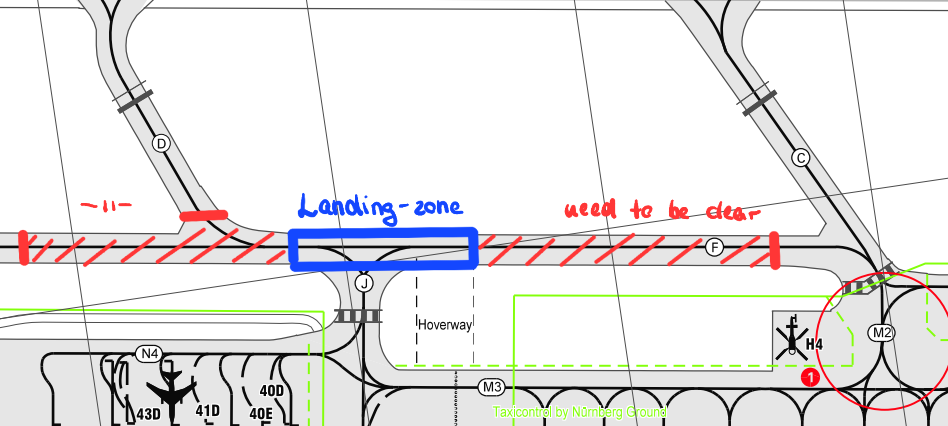Tower
Operating direction
The operating direction is coordinated between TWR and APP. Runway 28 is to be used in preference. The operating direction should only be changed during continuous traffic if a tailwind component of more than 5 KT is otherwise to be expected.
Please note that only runway 28 can be used for low visibility operations.
Change of operating direction
- TWR decides on a change of operating direction in consultation with APP and arranges a specific time for this
- Traffic is planned and cleared accordingly on the ground and in the air
- TWR report the last start in the old operating direction to Director and APP
- APP reports the callsigns of the last planned approaches in the old operating direction to the tower
- Director gives a 15NM check to the tower for the first approach in the new operating direction of a runway
Approaches
Approaches are to be staggered by APP and handed over on the approach base line at 8 NM at the latest
Non-precision approaches, aerodrome circuit approaches or approaches that do not wish to perform a final landing must be coordinated between the APP and TWR.
Visual approaches must be coordinated between TWR and APP. The requirements stipulated in the AIP must be observed; in exceptional cases (e.g. weather, emergencies, ambulance flights, etc.) this may be deviated from.
Required separation
APP is responsible for creating and maintaining the separation between approaches.
Speed instructions from TWR for approaches must be coordinated in advance. TWR is then responsible for maintaining the separation.
Missed approaches
A missed approach must be coordinated between the APP and TWR. Pilots should primarily follow the published missed approach procedure. In exceptional cases, a "fly runway track, climb to FL70" can also be instructed, which may be appropriate in Nuremberg if there is a lot of traffic.
Practice approaches
The published missed approach procedure must not be used for practice approaches with a new take-off/take-off, but a SID must always be assigned.
Departures
Separation obligation
TWR is responsible for establishing and maintaining the separation between two take-offs. The following aircraft may only be released for take-off if the radar separation minimum or the required wake turbulence separation to the preceding aircraft is given at the time of take-off and the separation remains or increases.
Intersection Departures
Airliners are always sent to the beginning of the runway. Deviations are possible with the pilot's consent. Pilots of small (VFR) aircraft must expect an intersection departure.
Intersection C should NOT be used due to inbound traffic. If you using them, advise the arriving traffic to vacate later than C!
VFR traffic
VFR arrivals and departures may enter or leave the control zone at a maximum of 3,000 ft AMSL. Circuits to the south should be avoided for noise protection reasons.
Helicopter take-offs and landings
Taxiway F can be used for take-offs and landings. The decision lies with the tower, the pilot must report if he cannot accept this. In most cases, however, these departures are carried out as intersection takeoffs from taxiway J.
Take-offs and landings of DRF rescue helicopters
The following procedures are to be observed when carrying out operational flights by the local DRF rescue helicopters (CHX27 and CHX88).
CHX27 must be assigned the discrete transponder code 7027.
CHX88 must be assigned the group code 0020 for rescue flights.
In order to avoid having to keep the entire TWY free when using the above procedure for departures from TWY F, the following procedure was agreed with the DRF (only for CHX27 and CHX88):
An artificial landing zone will be set up, which must be kept clear during take-offs and landings of the two rescue helicopters, extending westwards to the junction of TWY J and eastwards to the eastern boundary of the hoverway.
TWY C can therefore be used freely without further restrictions, provided that traffic information is provided on all aircraft involved.
Aircraft on TWY D must be clear of TWY F for the application of the procedure.
TWY F can only be used to the east as far as apron G3.
AD2 EDDN 2-7 - With the kind permission of DFS Deutsche Flugsicherung GmbH. Not suitable for navigational purposes.

